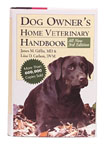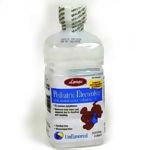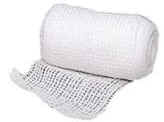Marli's Chi's - AKC Longcoat Chihuahuas
of San Jose, California
An inexpensive plastic toolbox or overnight/cosmetic case from a discount department store makes a good container for your first aid kit. Here are some items you may want to include:
 The Dog Owner's Home
Veterinary Handbook: by James M Griffin, MD
& Lisa D. Carlson, DVM Covers many dog health related topics including
info about vaccinations. Easy to follow directions & an alphabetized
emergency section explains how & when to treat a dog & when to
call a veterinarian. If you wish, you can purchase a smaller booklet or
pamphlet that is easier to store in your kit, but we still highly
recommend this book to anyone with a dog. We have found it to be
*extremely* useful and reliable. When attempting to treat your dog at
home, we highly recommend referring to a book or guide such as this for
safest results, but home treatment is not a substitute for treatment by a
trained and experienced veterinarian.
The Dog Owner's Home
Veterinary Handbook: by James M Griffin, MD
& Lisa D. Carlson, DVM Covers many dog health related topics including
info about vaccinations. Easy to follow directions & an alphabetized
emergency section explains how & when to treat a dog & when to
call a veterinarian. If you wish, you can purchase a smaller booklet or
pamphlet that is easier to store in your kit, but we still highly
recommend this book to anyone with a dog. We have found it to be
*extremely* useful and reliable. When attempting to treat your dog at
home, we highly recommend referring to a book or guide such as this for
safest results, but home treatment is not a substitute for treatment by a
trained and experienced veterinarian.
 Nutrical,
Vitacal, or Nutristat: High calorie,
vitamin enhanced dietary supplement provides extra energy and stimulates
appetite during periods of stress or illness.
Nutrical,
Vitacal, or Nutristat: High calorie,
vitamin enhanced dietary supplement provides extra energy and stimulates
appetite during periods of stress or illness.
 Electrolyte
solution: Use to prevent dehydration and replace
essential minerals and electrolytes lost in diarrhea and vomiting.
Pedialyte is the brand most people are familiar with, but it is fine to
use a generic Pediatric Electrolyte instead. There are also
electrolyte formulations made specifically for dogs.
Electrolyte
solution: Use to prevent dehydration and replace
essential minerals and electrolytes lost in diarrhea and vomiting.
Pedialyte is the brand most people are familiar with, but it is fine to
use a generic Pediatric Electrolyte instead. There are also
electrolyte formulations made specifically for dogs.
 Hills Science Diet
A/D: For the Nutritional Management of Pets
Recovering From Serious Illness, Accidents and Surgery. Dogs can undergo
significant changes when faced with a serious illness, injury or surgery.
They may have trouble maintaining natural defenses and sparing lean body
mass (in other words, they may be losing body weight from muscle or organ
tissue), which can affect recovery. Prescription Diet㡮ine/Feline a/dꠠ has been specifically formulated by veterinarians to be fed to dogs with
certain debilitating conditions. These conditions can be affected by the
lack of key nutrients and digestible energy. A less nutritious but more
inexpensive and easily located option would be to keep a jar or two of
strained lamb baby food in your kit, but I recommend the A/D. PLEASE
NOTE: I do NOT recommend Science Diet foods in general. I
feel there are much higher quality foods that are better for feeding a
normally healthy dog to keep them healthy.
Hills Science Diet
A/D: For the Nutritional Management of Pets
Recovering From Serious Illness, Accidents and Surgery. Dogs can undergo
significant changes when faced with a serious illness, injury or surgery.
They may have trouble maintaining natural defenses and sparing lean body
mass (in other words, they may be losing body weight from muscle or organ
tissue), which can affect recovery. Prescription Diet㡮ine/Feline a/dꠠ has been specifically formulated by veterinarians to be fed to dogs with
certain debilitating conditions. These conditions can be affected by the
lack of key nutrients and digestible energy. A less nutritious but more
inexpensive and easily located option would be to keep a jar or two of
strained lamb baby food in your kit, but I recommend the A/D. PLEASE
NOTE: I do NOT recommend Science Diet foods in general. I
feel there are much higher quality foods that are better for feeding a
normally healthy dog to keep them healthy.
Ipecac Syrup: Use to induce vomiting in case of
ingestion poisoning such as chocolate. It is a medicine that can
be purchased in any pharmacy without a prescription that, when given to a
dog, will cause vomiting. Syrup of
Ipecac should NOT be given at home if: your dog:
-
Swallowed a corrosive (lye, drain cleaners, oven cleaners, automatic dishwasher detergent, or other strong acids or bases) or burns are seen around or in the mouth or
-
Swallowed a petroleum distillate-containing product (kerosene, gasoline, paint thinner, furniture polish, etc.) or
-
Swallowed tranquilizers (which prevent vomiting) or
-
Swallowed a sharp object (which could lodge in the esophagus or perforate the stomach) or
-
Is lethargic (sluggish), asleep, or comatose (unconscious) or
-
Is convulsing or
-
You are unsure of the type of poison ingested or
-
If more than two hours have passed since the poison was swallowed.
Directions:
-
Give on teaspoonful (5 ml) of Syrup of Ipecac per 10 pounds of body weight.
- Immediately give fluids (except milk).
- Vomiting should occur in approximately 15-20 minutes.
- IF vomiting has not occurred in 20 minutes, see your vet.

Oral Syringe: Use to administer medications.

 Kaopectate
or Pepto Bismol: Use to treat diarrhea and
intestinal upset. In my experience, Kaopectate is indicated in cases where
the diarrhea is more watery and needs to be controlled quickly (such as in
cases of sudden food changes), Pepto Bismol is indicated more when
gassiness or stomach pain are part of the symptoms, but the diarrhea is
less severe (usually a case where the dog has ingested something
non-toxic, but is feeling discomfort as a result - grass, twigs, etc.).
Severe diarrhea, diarrhea for more than a day, or diarrhea accompanied by
vomiting and/or fever should always be treated by a veterinarian. Dosage:
1 teaspoon per 5 pounds every 4 hours.
Kaopectate
or Pepto Bismol: Use to treat diarrhea and
intestinal upset. In my experience, Kaopectate is indicated in cases where
the diarrhea is more watery and needs to be controlled quickly (such as in
cases of sudden food changes), Pepto Bismol is indicated more when
gassiness or stomach pain are part of the symptoms, but the diarrhea is
less severe (usually a case where the dog has ingested something
non-toxic, but is feeling discomfort as a result - grass, twigs, etc.).
Severe diarrhea, diarrhea for more than a day, or diarrhea accompanied by
vomiting and/or fever should always be treated by a veterinarian. Dosage:
1 teaspoon per 5 pounds every 4 hours.
 Children's
liquid Benedryl - dye and alcohol free: Use
to reduce symptoms of hay fever. Also use to reduce severity of mild
anaphylactic shock reaction (usually to vaccination, medication, or
insect bites or stings). In cases of a serious reaction, the medication
may buy you more time to get your dog to the vet for proper treatment, but
a more serious treatment will be required to save your dogs life.
Children's
liquid Benedryl - dye and alcohol free: Use
to reduce symptoms of hay fever. Also use to reduce severity of mild
anaphylactic shock reaction (usually to vaccination, medication, or
insect bites or stings). In cases of a serious reaction, the medication
may buy you more time to get your dog to the vet for proper treatment, but
a more serious treatment will be required to save your dogs life.
 Baby
Aspirin: Buffered children's aspirin. Use to treat pain for a
short duration or to treat fever until the affected dog can be gotten to a
veterinarian. Do not use for a prolonged period.
Baby
Aspirin: Buffered children's aspirin. Use to treat pain for a
short duration or to treat fever until the affected dog can be gotten to a
veterinarian. Do not use for a prolonged period. 
Hydrogen
Peroxide: Use for general wound cleaning and can
be used to induce vomiting if Ipecac syrup is not available. To induce
vomiting, give 1 teaspoon per 15 pounds of body weight every 10 minutes
until vomiting occurs. 
Betadine: Topical Antiseptic Microbicide. Helps prevent infection in cuts, scrapes, and minor burns...Forms Protective Film...Virtually Non-Irritating, Nonstaining to Skin. Recommended by Doctors & Nurses.
 Neosporin
or other Triple Antibiotic Ointment: For
topical treatment of minor cuts, scrapes or burns. Serious wounds or bite
wounds should always be treated by a veterinarian.
Neosporin
or other Triple Antibiotic Ointment: For
topical treatment of minor cuts, scrapes or burns. Serious wounds or bite
wounds should always be treated by a veterinarian.
 Sterile
Eye Wash: Use to flush foreign objects out of
the eye.
Sterile
Eye Wash: Use to flush foreign objects out of
the eye.
 Terramycin
or other Antibiotic Eye Ointment: Antibiotic
ointment used to prevent or treat primary &
secondary infections of the eye in small & large animals. Any
suspected eye injury or infection should be checked by a
veterinarian.
Terramycin
or other Antibiotic Eye Ointment: Antibiotic
ointment used to prevent or treat primary &
secondary infections of the eye in small & large animals. Any
suspected eye injury or infection should be checked by a
veterinarian.
 Thermometer:
Recommend getting a digital thermometer. The temperatures of dogs range
more than with humans so it is a good idea to take your dog's temperature
several times while he is healthy and keep a note of what his normal body
temperature is. A temperature of 103 or above indicates fever.
Thermometer:
Recommend getting a digital thermometer. The temperatures of dogs range
more than with humans so it is a good idea to take your dog's temperature
several times while he is healthy and keep a note of what his normal body
temperature is. A temperature of 103 or above indicates fever.
K-Y
Jelly: Sterile lubricant - primarily used for lubricating
thermometer prior to taking a temperature reading.

Cotton Swabs and Cotton Balls: Use to clean wounds or apply medication. Can also be used if sharp object is swallowed such as broken glass. Soak cotton balls in milk and feed to the affected dog. The indigestible cotton fibers will entangle the glass and allow the dog to pass the glass more safely and minimize damage until the dog can be treated by a vet.
 Hemostat:
Use to remove larger foreign objects or object that are firmly embedded or
hard to reach. Can also be used as a clamp.
Hemostat:
Use to remove larger foreign objects or object that are firmly embedded or
hard to reach. Can also be used as a clamp.
Tweezers: Use to remove small foreign objects.
 Safety
Tip Scissors: Use to trim hair away from a wound, cut bandages,
etc.
Safety
Tip Scissors: Use to trim hair away from a wound, cut bandages,
etc.
Otoscope
(Ear Scope): Lighted veterinary tool magnifies vision and
allows close up examination of the ear canal and throat. Remove scopes and
it can also be used as a "pen light". 
Disposable
Vinyl or Latex Gloves: Allows for more hygienic handling of
your pet's wounds and clean up afterwards.
Chew Deterrent: Granick's Bitter Apple or other brand of chew deterrent for dogs. Non-toxic, safe and effective taste deterrent. Stop pets from biting and chewing fur, wounds and bandages.
 3M
Vet Wrap or Co-Flex Bandage: Lightweight
bandage stretches & sticks to itself - not to hair or skin. Stays in
place to give firm support. Will not absorb moisture. Use to hold
dressings.
3M
Vet Wrap or Co-Flex Bandage: Lightweight
bandage stretches & sticks to itself - not to hair or skin. Stays in
place to give firm support. Will not absorb moisture. Use to hold
dressings. 
 Gauze
Bandage Roll and First Aid Tape
Gauze
Bandage Roll and First Aid Tape
Trauma Pad/Sterile Compress: Individually wrapped Sanitary napkins work well.
 Tongue
Depressors: Can be used as a splint, or
to block mouth open to see if there is an obstruction or to prevent biting
the tongue during a seizure.
Tongue
Depressors: Can be used as a splint, or
to block mouth open to see if there is an obstruction or to prevent biting
the tongue during a seizure.
 Muzzle:
Since even the smallest muzzles made are
often to big for a Chihuahua, a knee high nylon stocking
can be used as a make-shift muzzle on very small dogs. Stretch the
stocking lengthwise and, taking one end in each hand, tie around muzzle in
a single knot (as in image on right) on top of muzzle. Then bring
ends down and tie a second single knot below muzzle, and then bring ends
around each side of head and tie off behind head in a square knot. Do not
tie too tightly. A muzzle should never be used on a dog that is convulsing
or having difficulty breathing, and should only be used to prevent biting.
Muzzle:
Since even the smallest muzzles made are
often to big for a Chihuahua, a knee high nylon stocking
can be used as a make-shift muzzle on very small dogs. Stretch the
stocking lengthwise and, taking one end in each hand, tie around muzzle in
a single knot (as in image on right) on top of muzzle. Then bring
ends down and tie a second single knot below muzzle, and then bring ends
around each side of head and tie off behind head in a square knot. Do not
tie too tightly. A muzzle should never be used on a dog that is convulsing
or having difficulty breathing, and should only be used to prevent biting.
Disclaimer: Please note that this article is only recommended for the construction of a home first-aid kit for your dog, and that none of the items or treatments described here are suggested as a substitute for proper veterinary care. If your dog is injured or ill, having prepared a first-aid kid at home may help you to stabilize your dog's condition and give you more time to get to a vet for proper treatment, but we do not advise forgoing veterinary care and take no responsibility for the result should any individual choose to treat their dog only at home after having read this article. Recommended dosages are taken from the product labeling for from the Dog Owner's Home Veterinary Handbook and are suggestions only. Brand names in images do not necessarily denote recommendation of that brand. Specific mention of brand names is to help you locate the type of product recommended and does not necessarily denote a brand recommendation unless a recommendation is specifically stated. Any recommendations are based on my personal use of the products - your experience may differ. This article was not subsidized by any of the companies whose products are mentioned.